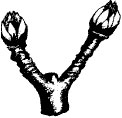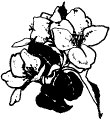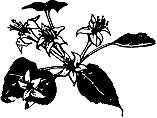Revised
Table 1
Pesticides used to control common diseases and insect pests on home fruit plants.

Apples and pears
- Dormant sprays
- Green tip to half-inch green sprays
- Prebloom or pink sprays
- Bloom sprays
- Petal-fall sprays
- Early-season cover sprays
- Summer cover sprays
Apples and pears
Dormant sprays
 Apply before buds swell.
Apply before buds swell.
Mites, scale
- Material
dormant oil - Comments
Oil smothers overwintering eggs of mites and scale.
Apply oil when temperature is above 40 degrees Fahrenheit.
When European red mite infestations are high, the bright red eggs may be seen on the smaller branches and twigs.
Fire blight
- Material
Bordeaux mixture - Comments
Apply alone — may have compatibility problems with other pesticides. Best if applied at the "silver tip" (bud swelling) stage. Do not apply after the "half-inch green" stage or when drying conditions are slow — severe plant injury may occur. - More information
G6020, Fire Blight.
Apples and pears
Green tip to half-inch green sprays
 Apply when green leaves are 0.25 to 0.5 inch long.
Apply when green leaves are 0.25 to 0.5 inch long.
Mites, scale
- Material
dormant
or summer oil - Comments
Oil application delayed until this time may give even better control of scale than when applied earlier. Eggs of European red mite start to hatch at this time.
Apply oil at temperatures above 40 degrees Fahrenheit, and do not apply within 14 days before or after using sulfur or captan.
Leafminers
- Material
esfenvalerate
or neem
or spinosad
or gamma-cyhalothrin - Comments
Newly developing mines appear as blotches only on the underside of the leaf, whereas completed mines buckle the leaf like a small tent (with white spots) and are visible on both the upper and lower leaf surfaces.
Neem (azadirachtin) is a botanical insecticide.
Spinosad is a naturally derived product from a species of bacteria.
Aphids
- Material
malathion
or neem
or insecticidal soap
or gamma-cyhalothrin - Comments
For insecticidal soap repeat application 3 to 4 days later.
Neem (azadirachtin) is a botanical insecticide.
Pear pyslla
- Material
esfenvalerate
or permethrin
or gamma-cyhalothrin - Comments
Pear pest only — can secrete large amounts of honeydew that covers the fruit and foliage. The honeydew serves as a substratum for the growth of a black fungus.
Do not make more than three permethrin sprays per season.
Primary scab
- Material
captan
or mancozeb
or myclobutanil
or sulfur - Comments
Do not apply captan with or immediately following an oil spray. Combining captan with Bordeaux mixture or lime sulfur will reduce effectiveness of captan. Combinations of captan and sulfur may cause necrotic spotting on leaves of susceptible varieties (e.g., Jonathan, MacIntosh).
captan is more effective on scab than sulfur.
Apples and pears
Prebloom or pink sprays
 Apply when blossom buds are clearly evident but not open.
Apply when blossom buds are clearly evident but not open.
Plant bugs, stink bugs
- Material
esfenvalerate
or permethrin
or gamma-cyhalothrin - Comments
Feeding injury results in aborted flowers and, later, in dimple-like scars on fruit.
Do not make more than three permethrin sprays per season.
Aphids
- Material
malathion
or carbaryl
or neem
or insecticidal soap
or gamma-cyhalothrin - Comments
See comments in "green-tip to half-inch green" section.
Pear psylla
- Material
esfenvalerate
or permethrin
or gamma-cyhalothrin - Comments
See comments in "green-tip to half-inch green" section.
Primary scab
- Material
captan
or mancozeb
or myclobutanil
or sulfur
or thiophanate-methyl - Comments
See comments in "green-tip to half-inch green" section.
Rust
- Material
mancozeb
or myclobutanil
or sulfur - Comments
MacIntosh, Golden Delicious, Jonathan, and certain other varieties may by injured by sulfur applications under certain conditions.Sulfur provides fair to poor rust control.
Powdery mildew
- Material
lime sulfur
or myclobutanil
or sulfur
or thiophanate-methyl - Comments
Combinations of captan and sulfur may cause necrotic spotting on leaves of susceptible varieties.
Apples and pears
Bloom sprays
 Apply when 25 percent of blossoms are open.
Apply when 25 percent of blossoms are open.
Do not use insecticides during this period — Save the bees.
Primary scab
- Material
captan
or mancozeb
or myclobutanil
or sulfur
or thiophanate-methyl - Comments
See comments in "green-tip to half-inch green" section.
Fire blight
- Material
streptomycin - Comments
Apply at first bloom on susceptible varieties. Repeat at 4 to 5 day intervals until the petal-fall stage. - More information
G6020, Fire Blight.
Rust
- Material
mancozeb
or myclobutanil
or sulfur - Comments
See comments in "prebloom or pink" section.
Powdery mildew
- Material
lime sulfur
or myclobutanil
or sulfur
or thiophanate-methyl - Comments
See comments in "prebloom or pink" section.
Apples and pears
Petal-fall sprays
 Apply when most of blossom petals have fallen.
Apply when most of blossom petals have fallen.
Plum curculio, leafrollers
- Material
esfenvalerate
or malathion
or permethrin
or spinosad
or gamma-cyhalothrin - Comments
Surface feeding and egg laying by overwintering adult plum curculio scar (crescent-shaped cuts) or misshape (bumps) the fruit by harvest. Internal feeding by larvae may cause some premature fruit drop.Peak egg hatch of redbanded leafroller usually coincides with petal fall.
Some labels indicate no applications of permethrin after petal-fall.
Spinosad for leafrollers only.
Plant bugs, stink bugs
- Material
esfenvalerate
or malathion
or insecticidal soap
or permethrin
or gamma-cyhalothrin - Comments
See comments in "prebloom to pink" section.
For insecticidal soap repeat application 3 to 4 days later.
Some labels indicate no applications of permethrin after petal-fall.
Aphids
- Material
malathion
or insecticidal soap
or neem
or permethrin
or imidacloprid
or gamma-cyhalothrin - Comments
Rosy apple aphid feeding often causes leaves to curl.See comments in "green-tip to half-inch green" section.
Some labels indicate no applications of permethrin after petal-fall.
One application of imidacloprid per year.
Leafminers
- Material
esfenvalerate
or neem
or permethrin
or spinosad
or imidacloprid
or gamma-cyhalothrin - Comments
See comments in "green-tip to half-inch green" section.Some labels indicate no applications of permethrin after petal-fall.
One application of imidacloprid per year.
Pear psylla
- Material
esfenvalerate
or malathion
or gamma-cyhalothrin - Comments
See comments in "green-tip to half-inch green" section.
Scab
- Material
captan
or mancozeb
or myclobutanil
or sulfur
or thiophanate-methyl - Comments
See comments in "green-tip to half-inch green" section.
Rust
- Material
mancozeb
or myclobutanil
or sulfur - Comments
See comments in "prebloom or pink" section.
Powdery mildew
- Material
lime sulfur
or myclobutanil
or sulfur
or thiophanate-methyl - Comments
See comments in "prebloom or pink" section.
Apples and pears
Early-season cover sprays
Apply 10 days after petal-fall and at 10-day intervals through May.
Codling moth, leafrollers
- Material
carbaryl
or esfenvalerate
or malathion
or spinosad
or gamma-cyhalothrin - Comments
These sprays are critical for first-generation codling moth control.
Codling moth larvae damage apples and pears by burrowing to the core (usually from the apple side or calyx end) with brown frass (fecal material) exuding from the entry site. In Missouri, there are often three generations of codling moth per season.
Leafroller damage consists of skeletonized leaves folded together by webbing or attached to fruit where the larvae feed on the fruit surface making shallow, irregular channels.
Do not apply carbaryl within 30 days after bloom to avoid possible fruit thinning.
Spinosad for leafrollers only.
Plum curculio
- Material
carbaryl
or esfenvalerate
or malathion
or gamma-cyhalothrin - Comments
See comments in "petal-fall" section.
Emerging adults in the summer feed on apples for a short time, causing round feeding scars on the fruit surface. Severely infested fruit may be covered with bumps and scarred at harvest.
Do not apply carbaryl within 30 days after bloom to avoid possible fruit thinning.
Aphids
- Material
insecticidal soap
or malathion
or neem
or imidacloprid
or gamma-cyhalothrin - Comments
See comments in "petal-fall" section.
Powdery mildew
- Material
lime sulfur
or myclobutanil
or sulfur
or thiophanate-methyl - Comments
Discontinue sulfur use when temperatures reach 90 degrees Fahrenheit.
Leafminers
- Material
carbaryl
or esfenvalerate
or neem
or imidacloprid
or spinosad
or gamma-cyhalothrin - Comments
See comments in "green-tip" section.
High populations can cause severe defoliation, leading to reduced fruit and terminal growth, early leaf drop, and reduced fruit set the following season.
Do not apply carbaryl within 30 days after bloom to avoid possible fruit thinning.
Mites
- Material
malathion
or summer oil
or insecticidal soap
or neem - Comments
Severe mite feeding results in brown foliage that eventually becomes bronzed (due to the removal of leaf cell contents, including chlorophyll).
To prevent damage to foliage or fruits, never use a summer oil with captan, carbaryl, or other sulfur-containing pesticides. Allow at least 14 days between applications of sulfur-containing compounds and the use of a summer oil. Apply oil at temperatures above 40 degrees Fahrenheit and below 90 degrees Fahrenheit.
For insecticidal soap repeat application 2 to 3 days later.
Scale
- Material
carbaryl
or summer oil
or insecticidal soap
or imidacloprid - Comments
Scale crawlers typically active at this time.
Do not apply carbaryl within 30 days after bloom to avoid possible fruit thinning.
To prevent damage to foliage or fruits, never use a summer oil with captan, carbaryl, or other sulfur-containing pesticides. Allow at least 14 days between applications of sulfur-containing compounds and the use of a summer oil. Apply oil at temperatures above 40 degrees Fahrenheit and below 90 degrees Fahrenheit.
For insecticidal soap repeat application 2 to 3 days later.
One application of imidacloprid per year.
Pear psylla
- Material
carbaryl
or esfenvalerate
or gamma-cyhalothrin - Comments
See comments in "green-tip to half-inch green" section.
Scab
- Material
captan
or myclobutanil
or sulfur
or thiophanate-methyl - Comments
See comments in "green-tip to half-inch green" section.
Rust
- Material
myclobutanil
or sulfur - Comments
See comments in "prebloom or pink" section.
Fruit rots
- Material
captan
or thiophanate-methyl - Comments
These fungicides may be combined for increased effectiveness.
Apples and pears
Summer cover sprays
Apply at 14-day intervals, June through mid-August.
Codling moth, leafrollers
- Material
carbaryl
or esfenvalerate
or malathion
or spinosad
or gamma-cyhalothrin - Comments
See comments in "early-season cover sprays" section. - Days between last application and harvest
Table 2
Mites
- Material
summer oil
or malathion
or insecticidal soap
or pyrethrins and rotenone - Comments
See comments in "early-season cover sprays" section. - Days between last application and harvest
Table 2
Scale
- Material
summer oil
or carbaryl
or insecticidal soap
or gamma-cyhalothrin - Comments
See comments in "early-season cover sprays" section.
On fruit the San Jose scale can be seen as a conspicuous red spot. Apply pesticide when crawlers are active. - Days between last application and harvest
Table 2
Leafhoppers
- Material
carbaryl
or esfenvalerate
or neem
or gamma-cyhalothrin - Comments
Damaged foliage (upper leaf surface) becomes speckled or mottled with white spots. - Days between last application and harvest
Table 2
Leafminers
- Material
carbaryl
or esfenvalerate
or neem
or spinosad
or gamma-cyhalothrin - Comments
See comments in "early-season cover sprays" section. - Days between last application and harvest
Table 2
Aphids
- Material
insecticidal soap
or malathion
or neem
or gamma-cyhalothrin - Comments
See comments in "petal-fall sprays" section. - Days between last application and harvest
Table 2
Scab, fruit rots, sooty blotch and fly speck
- Material
captan
or thiophanate-methyl - Comments
These fungicides may be combined for increased effectiveness. - Days between last application and harvest
Table 2